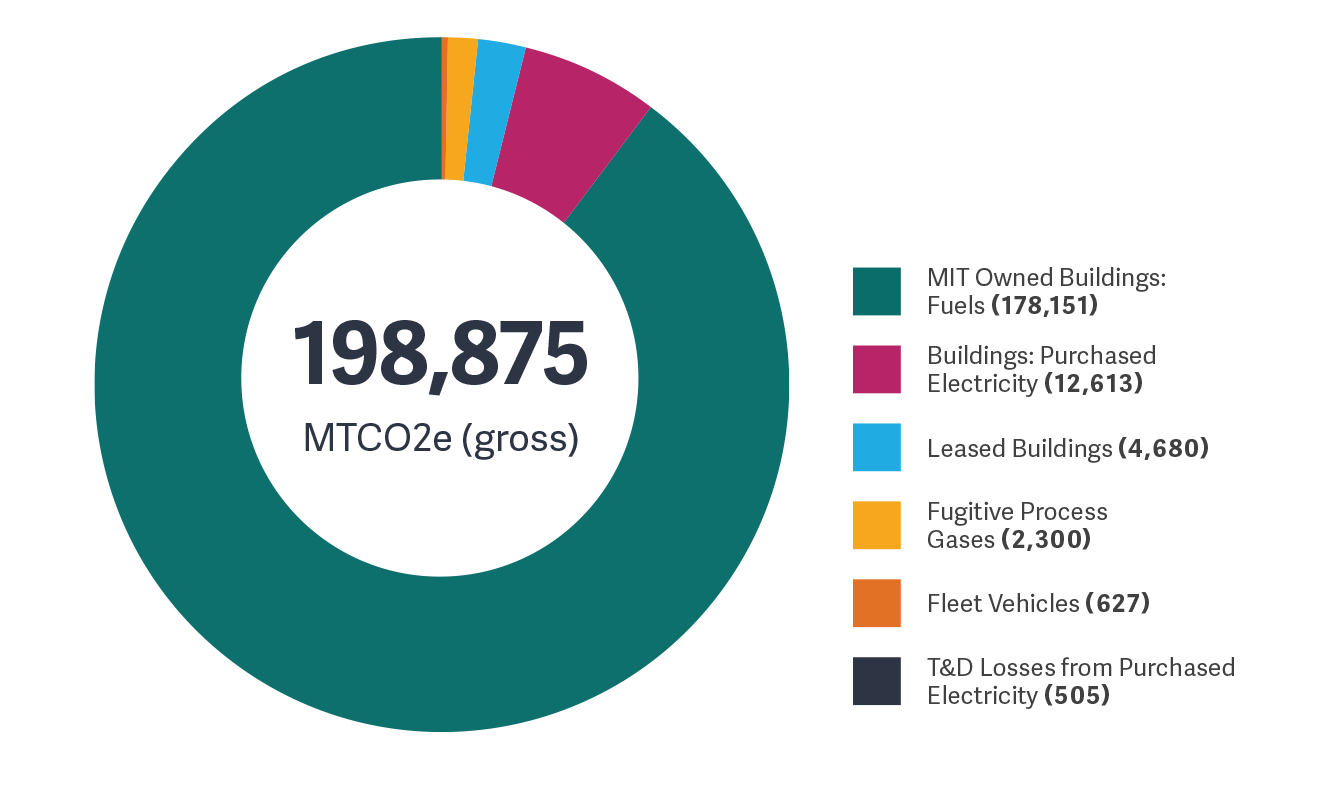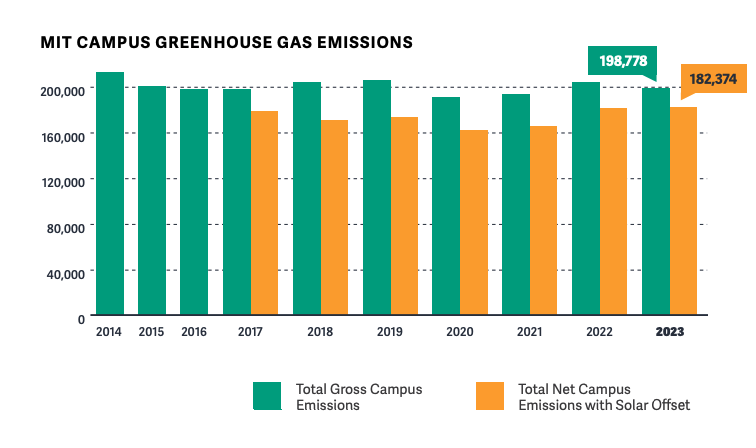Decarbonizing MIT
In fiscal year 2023, there was a 2.4 percent reduction in building-related on-campus emissions over the previous year. Including all sources of campus emissions, as well as the impact of MIT’s current solar power purchase agreement (PPA), MIT’s net emissions in 2023 were 14 percent below the 2014 baseline.
The reduction of campus emissions can be attributed to the first full-year of operation of MIT’s new cogeneration plant combined with several completed building-level energy efficiency projects. As the Institute has set a goal of campus decarbonization by 2050, stakeholders continue to lay the groundwork to accelerate campus decarbonization efforts through additional novel approaches. In the near-term, the Institute continues progress toward its 2026 goal of seeking a net-zero campus.
Alongside the efforts on campus, MIT is leading work with a number of partners to spur the creation of multiple large-scale renewable energy projects, including wind and solar. These projects will have an immediate and significant impact of reducing emissions through the urgently-needed decarbonization of regional power grids.
MIT Greenhouse Gas Emissions Sources, FY2023

Retrofits and Pilots
Large-scale building efficiency projects are essential to MIT reducing its campus emissions. This past year, Building 46 (Brain and Cognitive Sciences Complex)—one of the top energy consumers on campus—underwent work toward a planned energy reduction of 35 percent, which is anticipated to reduce total campus emissions by 2 percent. The effort reached all 1,254 spaces in the research and office building and optimized ventilation, converted fume hoods from constant volume to variable volume, and installed equipment to help the building systems run more efficiently.
Energy efficiency work also launched in Building 68 (David H. Koch Biology Building), another top energy consumer on campus. Each building efficiency project begins with an energy assessment, and with the Building 68 assessment, it was quickly identified that the building’s existing heat recovery system wasn’t working optimally. A team representing Campus Construction, Engineering & Energy Management, and Campus Services & Maintenance joined forces to optimize the system operation, and achieve significant heating energy reduction over the last 12 months.
AI Building Controls
In 2023, researchers in partnership with staff from the Department of Facilities and the Office of Sustainability began piloting artificial intelligence that works with existing building management systems to support dynamic heating and cooling of individual campus spaces to lower energy use and emissions in buildings. Researchers worked to establish a framework to understand and predict optimal temperature setpoints at the room level and take into consideration a host of internal factors like occupancy fluctuations and external factors such as forecasted weather or the carbon intensity of the grid. This allowed the existing systems to heat and cool more efficiently, all without manual intervention. Thanks to staff support to ready buildings for the new technology, the program aims to add additional campus buildings to the AI control platform as soon as the pilots are complete.

Increasing GHG Accounting Work
FY2023 marks the first year that MIT has calculated emissions from off-campus sites. This data from Bates Research and Engineering Center, Haystack Observatory, and Endicott House provides a more complete picture of MIT’s emissions and the scope of work needed to mitigate these emissions. These off-site emissions will add approximately 3,000 MTCO2e to our campus footprint. Note:These emissions are NOT included in the total emissions reported this year relative to our 2014 baseline, but reported here separately.
Net Zero Reporting
The concept of net-zero emissions reflects an interim objective to balance an organization's current emissions with an equal volume of reductions achieved elsewhere. As MIT decarbonizes its campus, investments are simultaneously being made to enable new renewable energy projects that will reduce emissions regionally and accelerate the decarbonization of electricity grids.
MIT continues to report its full, on-campus emissions as well as the impact of its renewable energy purchases in both megawatt hours and equivalent greenhouse gas emissions avoided. This allows for a transparent approach to reporting emissions performance. MIT reports each year its total gross campus emissions, as well as the total net campus emissions that includes the impacts of the renewable energy purchased. MIT's total emissions will be dynamic each year as we begin to include the impacts of off-campus facilities, business travel and commuting, and the volume of energy generated from solar and wind projects.
Summit Farms PPA
In 2023, through the purchase of 54,795 megawatt hours of solar power from Summit Farms, MIT offset 15,733 MTCO2E from on-campus operations. However, due to a major system-wide shut down at the solar facility that reduced production, the offset benefit to MIT was reduced 28 percent from the previous year.


